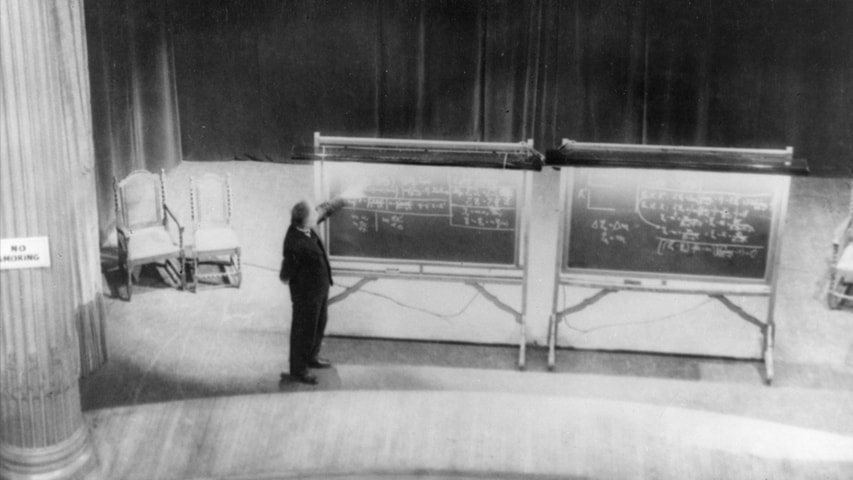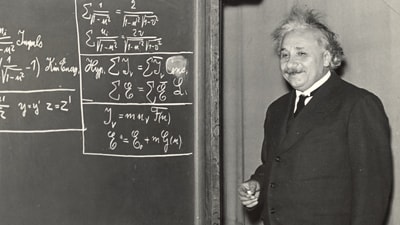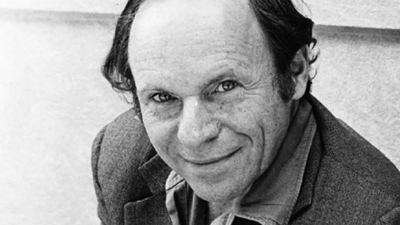Einstein's Visit Created Iconic Image, Sparked Student To Become Influential Scientist
On Dec. 28, 1934, the famous physicist explained his theory to a packed theater on CMU's campus

Courtesy of The Jacob Rader Marcus Center of the American Jewish Archives, Cincinnati, Ohio. Americanjewisharchives.org. This is the only known image of Einstein with a variant of his famous equation, E = mc2.
Albert Einstein was already a celebrity when he arrived in Pittsburgh 82 years ago to deliver a lecture at the Carnegie Institute of Technology, now known as Carnegie Mellon University.
The equivalence of mass and energy, commonly referred to by the equation E = mc2, was part of his theory of special relativity, which was the topic of his Josiah Gibbs Lecture during the American Mathematical Society (AMS) Conference.
 Courtesy of The Jacob Rader Marcus Center of the American Jewish Archives, Cincinnati, Ohio. Americanjewisharchives.org. Einstein visited the Carnegie Institute of Technology in 1934.
Courtesy of The Jacob Rader Marcus Center of the American Jewish Archives, Cincinnati, Ohio. Americanjewisharchives.org. Einstein visited the Carnegie Institute of Technology in 1934.
Einstein's brief visit to campus produced the only known photograph of him in front of a blackboard with a variant of his famous equation. The photograph, taken from a balcony of the Little Theaters, now known as Kresge Theater, is foggy but decipherable.
Fred Gilman, former dean of the Mellon College of Science, said the event was one of a series of remarkable connections between Carnegie Tech and members of the Manhattan Project, which developed the first atomic bomb.
A lesser-known story was the attendance of Philip Morrison, a young physics student who snuck into the event and may have seen that lecture as an inspiration for his life's work. He went on to help build the first atomic bomb, rally against the nuclear arms race, extend science outreach and begin the search for extraterrestrial life.
Although Einstein's lecture was just one of many events at the AMS Conference, press coverage focused almost exclusively on him. The event was one of his first major public appearances in the U.S. after arriving at the Institute for Advanced Study.
"People clambered to see Einstein's lecture because he was one of the world's first rock-stars," said Gregg Franklin, a professor of physics at CMU. "In his words, Einstein's famous E = mc2 equation tells us that 'mass and energy are both manifestations of the same thing — a somewhat unfamiliar conception for the average mind.'"
On the 82nd anniversary of the event, the photograph and lecture are still topics of discussion, said David Topper, a Pittsburgh native and a professor of the History of Science at the University of Winnipeg who has written several books about Einstein.
The Gibbs lectures, which were established by the AMS in 1923 and continue today, are intended for a general audience. While Einstein delivered his lecture in English — a rarity — and spoke less than an hour, he did not simplify the language, which Topper said was typical for an Einstein lecture.
Most of the 350 attendees in the audience were AMS members, though a small portion of tickets was available to the general public. According to some reports, scalpers were selling tickets for as much as $50 and almost a thousand hopeful attendees showed up at the theater.
Topper wrote that Morrison and a friend from the Drama Department, who had a key to the theater, snuck in. Despite having suffered polio, Morrison climbed to the scaffolding above the stage "where all they could see was the top of Einstein's head."
After the talk, Einstein answered questions at a press conference, where one reporter knew something about physics.
"Einstein was asked if you could get useful energy out of E = mc2," Gilman said. "He did not believe it was possible, invoking physics processes at the atomic scale. Four years later fission of the uranium nucleus was discovered."
 Philip Morrison, Courtesy of NASA
Philip Morrison, Courtesy of NASA
Morrison graduated from Carnegie Tech in 1936 and went on to receive his Ph.D. in theoretical physics from the University of California at Berkeley under J. Robert Oppenheimer, who later recruited him to work for the Manhattan Project.
"It was one of those incredible coincidences," Gilman said, "that ten-and-a-half years after the lecture, it was Phil Morrison who went to a safe in Los Alamos, took out the plutonium core for the first bomb and then assembled it for the first nuclear explosion at Almagordo, N.M. Many millions of time the energy was produced compared to the plutonium being replaced by TNT."
When Morrison died in 2005, a New York Times obituary described him as not being surprised by the light of the explosion, but by its heat.
Morrison later became a vocal advocate for international arms control and helped found the Federation of American Scientists for that cause. He also popularized science through shows such as the PBS series "The Ring of Truth," and as a script writer and narrator for the 1977 film "Powers of Ten."